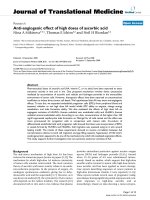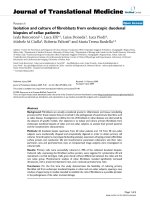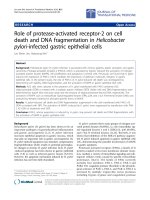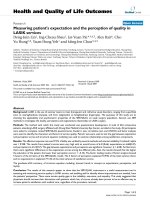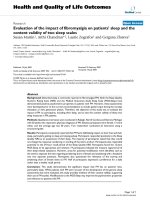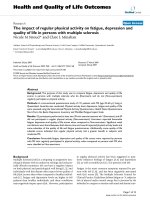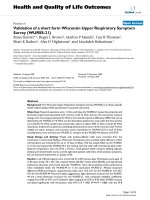báo cáo hóa học:" Indium tin oxide exhibiting high poly-crystallinity on oxygen plasma-treated polyethylene terephthalate surface" pdf
Bạn đang xem bản rút gọn của tài liệu. Xem và tải ngay bản đầy đủ của tài liệu tại đây (600.82 KB, 11 trang )
This Provisional PDF corresponds to the article as it appeared upon acceptance. Fully formatted
PDF and full text (HTML) versions will be made available soon.
Indium tin oxide exhibiting high poly-crystallinity on oxygen plasma-treated
polyethylene terephthalate surface
Nanoscale Research Letters 2012, 7:118 doi:10.1186/1556-276X-7-118
Phil Kook Son ()
Suk-Won Choi ()
Sung Soo Kim ()
ISSN 1556-276X
Article type Nano Express
Submission date 11 September 2011
Acceptance date 13 February 2012
Publication date 13 February 2012
Article URL />This peer-reviewed article was published immediately upon acceptance. It can be downloaded,
printed and distributed freely for any purposes (see copyright notice below).
Articles in Nanoscale Research Letters are listed in PubMed and archived at PubMed Central.
For information about publishing your research in Nanoscale Research Letters go to
/>For information about other SpringerOpen publications go to
Nanoscale Research Letters
© 2012 Son et al. ; licensee Springer.
This is an open access article distributed under the terms of the Creative Commons Attribution License ( />which permits unrestricted use, distribution, and reproduction in any medium, provided the original work is properly cited.
1
Indium tin oxide exhibiting high poly-crystallinity on oxygen plasma-treated
polyethylene terephthalate surface
Phil Kook Son
1,3
, Suk-Won Choi*
1,3
, and Sung Soo Kim
2,3
1
Department of Advanced Materials Engineering for Information & Electronics, Kyung Hee University,
Yongin, Gyeonggi-do, 446-701, Republic of Korea
2
Department of Chemical Engineering, Kyung Hee University, Yongin, Gyeonggi-do, 446-701,
Republic of Korea
3
Regional Innovation Center-Components and Materials for Information Display, Kyung Hee
University, Yongin, Gyeonggi-do, 446-701, Republic of Korea
*Corresponding author:
Email addresses:
PKS:
SWC:
SSK:
Abstract
Low-resistivity indium tin oxide [ITO] film was successfully deposited on oxygen plasma-treated
polyethylene terephthalate [PET] surfaces at room temperature. X-ray diffraction [XRD] measurements
demonstrated that the film deposited on the PET surface that had not been treated with oxygen plasma
had an amorphous structure. In contrast, after the low-power oxygen plasma treatment of the PET
surface, the ITO film deposited on the PET surface had a poly-crystalline structure due to interactions
between electric dipoles on the PET surface and electric dipoles in the ITO film. The minimum
resistivity of the poly-crystalline ITO was about 3.6 times lower than that of the amorphous ITO film. In
addition, we found that the resistivity of ITO film is proportional to the intensity of the (400) line in the
film's XRD spectra.
Keywords: ITO film; XRD; poly-crystal; PET; low resistivity.
Background
Transparent conducting oxide [TCO] films have been widely used as transparent electrodes in the field
of optoelectronic devices. Specifically, they have been used in applications such as liquid crystal
displays, organic light-emitting diodes, e-papers, and thin-film solar cells [1-4]. It is well known that the
performance of such devices is closely related to the physical properties (for example, the electrical and
optical properties) of the TCO [5]. Indium tin oxide [ITO] is the most widely used TCO because of its
excellent electrical and optical characteristics. However, ITO requires high process temperatures
2
(greater than 200°C) in order to obtain these favorable characteristics. This is because an additional
annealing treatment is needed to transform its structure from amorphous to poly-crystalline. Thus, it is
difficult to apply ITO films onto flexible plastic substrates such as polyethylene terephthalate [PET],
polyimide, polyethylene naphthalate, and polycarbonate because these polymer substrates have low
glass transition temperatures [6]. In general, there are several disadvantages to fabricating ITO on plastic
substrates as opposed to glass substrates, which can be fabricated with a relatively low treatment
temperature. These disadvantages include low transmittance, low conductivity, and many defects.
Therefore, the development of a low temperature process for depositing ITO onto plastic substrates is
very important.
In this work, we present an intriguing technique for fabricating high-performance ITO film on PET
without an additional annealing process. Using this method, ITO film with a poly-crystalline structure
can be manufactured on oxygen plasma-treated PET surfaces without an additional annealing process.
The physical properties of the deposited ITOs on the oxygen plasma-treated PET surfaces are discussed
as a function of oxygen plasma power. It is found that the poly-crystalline content of ITO can be
optimized by controlling the oxygen plasma power on PET surface.
Methods
ITO films were deposited onto non-treated PET using a radio frequency magnetron sputtering system
and low-power oxygen plasma-treated PET. Argon (49.7 sccm) was used as the inert gas in the chamber,
and oxygen (0.3 sccm) was also used in the chamber. The base pressure of the deposition chamber was
around 10
−6
Torr, and the working process pressure was around 10
−2
Torr. ITO films with a thickness of
50 nm were deposited at room temperature. The oxygen plasma-treated PET surfaces were bombarded
by a low-power oxygen gas. The oxygen plasma power, incident angle, and exposure time were 30 to
100 W, 70°, and 5 s, respectively.
X-ray diffraction [XRD] measurements of the SiOx film were performed using an X-ray diffractometer
(X'Pert Pro, Philips, PANalytical B.V., Almelo, The Netherlands) equipped with monochromic CuKα
radiation (λ = 1.054056 Å) operated at 40 kV and 30 mA. The diffraction pattern was measured at room
temperature in normal θ-2θ scanning mode over angles ranging from 10° to 90° with a step of 0.05°, and
measurements were performed at a rate of 0.2 s/step.
We also characterized the film's surface morphology using atomic force microscopy [AFM] in the
tapping mode (Multimode AFM Nanoscope IIIa, Digital Instruments, Inc., Tonowanda, NY, USA). An
ultra-lever cantilever with a spring constant of 26 N/m and a resonance frequency of 268 kHz was used
for scanning. Optical transmittance measurements were carried out with an UV-Vis NIR spectrometer.
The wetting properties of the surfaces were determined by the static contact angle method. The contact
angles were measured by increasing and then decreasing the volume of a drop of liquid (distilled water)
deposited on the sample surface. Recorded images were digitized and analyzed with a software routine
that evaluated the tangent at the point of contact between the drop and the surface (i.e., the contact
angle).
Measurements to determine the resistivity of the thin films were performed using a four-point probe test.
3
Rectangular sections (3 × 1 cm
2
) were cut from the substrate. The surfaces of the sections were cleaned
thoroughly before the resistivity measurements were made. The four-point probe was placed in contact
with the surface of the film, and a fixed current of 10 mA was applied across the outer two probes. The
voltage drop across the two inner probes was measured.
Results and discussion
Figure 1 shows the XRD results for ITO films deposited on non-treated and oxygen plasma-treated PET
film without any additional annealing process. From the XRD data, it was found that amorphous ITO
was deposited on the non-treated PET, while poly-crystalline ITO was deposited on the oxygen plasma-
treated PET. Specifically, poly-crystalline ITO was formed on the PET treated with an oxygen plasma
power of 40 W. In the cases where oxygen plasma treatment was performed with a power greater than
50 W, from the intensity of the (400) line in the XRD spectra, it was found that the proportion of poly-
crystalline structure began to decrease. Therefore, it was found that there was an optimal condition for
the oxygen plasma treatment of PET to maximize the poly-crystalline content of the deposited films.
To obtain more information about the oxygen plasma-treated PET surfaces, we measured the
morphologies and transmittance properties of the PET surfaces. Figure 2a,b shows the morphologies of
non-treated and oxygen plasma-treated PET surfaces, respectively, measured via AFM. The observed
surface roughness was increased by the oxygen plasma treatment. The surface roughness remained
constant at approximately 2.85 ± 0.6 nm irrespective of the oxygen plasma power (approximately 100
W). As shown in Figure 3, the transmittance of the PET film treated below the optimum oxygen plasma
power of 40 W was similar to that of non-treated PET film. In contrast, the transmittance of PET film
treated at oxygen plasma powers above 50 W was slightly lower than that of the non-treated PET film.
Figure 4 shows the measured contact angles on PET surfaces as a function of the oxygen plasma power.
As shown in Figure 4, the contact angle was altered dramatically by the oxygen plasma power. In the
range of approximately 30 to 50 W, the deposited ITO exhibited a poly-crystalline structure, and the
evaluated contact angle was relatively high (about 76° to 80°). When the power was greater than 50 W,
the poly-crystallinity of the deposited ITO was decreased, and the contact angle was below 55°. From
the contact angle experimental data, we found that the oxygen plasma-treated PET film had a high
contact angle. This is due to the surface charges (electric dipole moments) on the PET film surface [7].
We suggest that electric dipole-dipole interactions between the ITO film and the oxygen plasma-treated
PET surfaces play a dominant role in the formation of poly-crystalline ITO on low-energy ion beam-
treated inorganic surfaces. Figure 5 shows the resistivity of the ITO on PET as a function of the oxygen
plasma power. The observed resistivity of the ITO deposited onto a surface treated with 40 W of oxygen
plasma was considerably lower than that of the ITO deposited on non-treated PET. However, the
observed resistivity of the deposited ITO increased from 0.9 × 10
−3
Ω cm to 3.9 × 10
−3
Ω cm as the
oxygen plasma power was increased from 50 to 100 W. We also measured the intensity of the (400) line
of XRD as a function of the oxygen plasma power. As shown in Figure 5, the curve of the resistivity is
similar to that of the intensity of the (400) line of XRD. The similarity of these trends indicates that the
electrical property strongly depends on the poly-crystallinity of the deposited ITO. From our
measurements, the maximum electrical conductivity of the ITO on the oxygen plasma-treated PET was
approximately 3.6 times higher than that of the ITO on non-treated PET.
4
Conclusion
We successfully manufactured ITO that exhibits high poly-crystalline content on oxygen plasma-treated
PET surfaces without an additional annealing process. Before the oxygen plasma treatment of the PET
surface, the ITO deposited on the PET surfaces exhibited an amorphous structure. In contrast, after the
oxygen plasma treatment on PET film, the ITO deposited on the PET surfaces had a poly-crystalline
content that depended on the oxygen plasma power. We found that the optimum poly-crystallinity of
ITO could be achieved by controlling the oxygen plasma power used on the PET surface. The minimum
resistivity of the ITO on the oxygen plasma-treated PET was about 3.6 times lower than that of the ITO
on non-treated PET.
Competing interests
The authors declare that they have no competing interests.
Authors' contributions
PKS and SWC acquired and interpreted the data, carried out the analysis, and drafted the manuscript.
PKS participated in XRD and AFM measurements. PKS acquired the optical transmittance, contact
angle, and resistivity data. SWC and SSK have been involved in revising the manuscript and have given
the final approval of the version to be published. All authors read and approved the final manuscript.
Acknowledgment
This work was supported by a grant from Kyung Hee University in 2011 (KHU-20110184).
References
1. Heo GS, Matsumoto Y, Gim IG, Lee HK, Park JW, Kim TW: A study on crystallization, optical
and electrical properties of the advanced ZITO thin films using co-sputtering system. Solid State
Commun 2010, 150:223.
2. Wong FL, Fung MK, Tong SW, Lee CS, Lee ST: Flexible organic light-emitting device based on
magnetron sputtered indium-tin-oxide on plastic substrate. Thin Solid Films 2004, 466:225-230.
3. Cheng YT, Ho JJ, Wang CK, Lee W, Lu CC, Yau BS, Nain JL, Chang SH, Chang CC, Wang KL:
Improvement of organic solar cells by flexible substrate and ITO surface treatments. Appl Surf Sci
2010, 256:7606-7611.
4. Ito N, Sato Y, Song PK, Kaijio A, Inoue K, Shigesato Y: Electrical and optical properties of
amorphous indium zinc oxide films. Thin Solid Films 2006, 496:99-103.
5. Lee DY, Lee JR, Lee GH, Song PK: Study on In–Zn–Sn–O and In–Sn–Zn–O films deposited on
PET substrate by magnetron co-sputtering system. Surf Coat Technol 2008, 202:5718-5723.
5
6. Rebouta L, Rubio-Peña L, Oliveira C, Lanceros-Mendez S, Tavares C J, Alves E: Strain dependence
electrical resistance and cohesive strength of ITO thin films deposited on electroactive polymer.
Thin Solid Films 2010, 518:4525-4528.
7. Son PK, Park JH, Kim JC, Yoon TH, Rho SJ, Shin ST, Kim JS, Lim SK, Souk JH: Control of liquid
crystal alignment on SiOx film surfaces by low-energy ion beam. Jpn J Appl Phys 2009, 48:056503.
Figure 1. XRD spectra for ITO films deposited on PET films. These ITO films were deposited on
non-treated and oxygen plasma-treated (40 and 80 W, respectively) PET films without any additional
annealing process.
Figure 2. AFM images of (a) non-treated and (b) oxygen plasma-treated PET surfaces.
Figure 3. Transmittance curves of non-treated and oxygen plasma-treated (50 and 80 W,
respectively) PET films.
Figure 4. Measured contact angles on oxygen plasma-treated PET surfaces as a function of oxygen
power.
Figure 5. Film evaluated resistivity and (400) line of XRD intensity as a function of oxygen power.
20 30 40 50 60 70 80
(800)
(440)
(622)
(411)
(611)
(400)
(222)
ITO/ non-treated PET
ITO/ 40W oxygen-treated PET
ITO/ 80W oxygen-treated PET
Intensity [arb. unit]
2 Theta [deg.]
Figure 1
(a)
(b)
Figure 2
400 500 600 700
60
70
80
90
non-treated PET
40 W Oxygen-treated PET
80 W Oxygen-treated PET
Transmittance [%]
Wavelength [nm]
Figure 3
0 20 40 60 80 100
40
50
60
70
80
Contact angle [deg.]
Oxygen plasma power [W]
Figure 4
Figure 5
